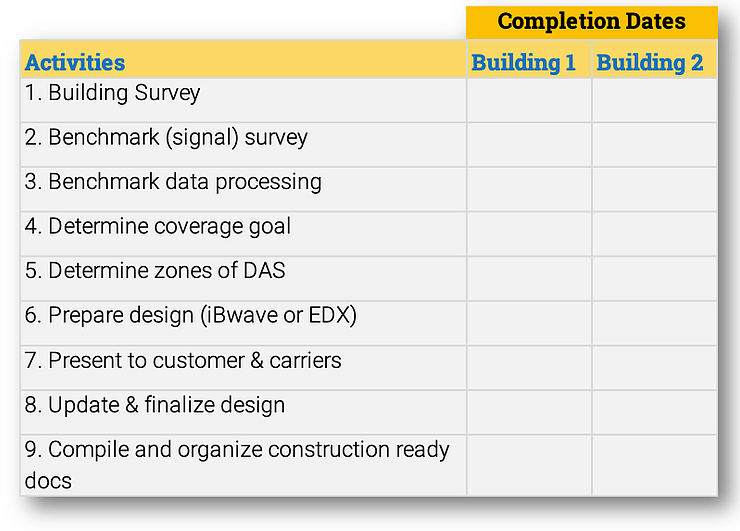Project Management: DAS Survey & Engineering
In this post, we will go through the milestones of Survey and Engineering process (please see snapshot below).
I have the milestones under the Activities Column. In the next 2 columns, in this example, I am assuming that you will enter completion dates for building 1 and 2. You can replace Buildings 1 & 2 with the buildings you are working with. You can also add more buildings if you wish. Milestones discussed here will typically be common for most buildings.
First milestone is building survey: Vendor will collect building information and any special requirement applicable to DAS construction. For example, if this is a DAS for Hospital then make sure that the vendors know the rules regarding infectious control. This is a very important phase of the project where lack of information can make significant effect later on labor or materials cost.
Next, benchmark survey: Vendor will collect this data by walking around the building. Benchmark survey is crucial to figure out floor by floor coverage goals. Engineers use various tools to complete this walk as we have described before.
Benchmark data processing: The data vendor collected in benchmark survey needs extensive post-processing, and although there are several data processing software available, this can take a few days to 2-3 weeks depending on the area engineers are trying to cover. Make sure to get a summary profile from this data collection.
Note that if this is a new building and not yet constructed, as a customer you may want the engineers to proceed with the design engineering portion, and then do the benchmark testing once the exterior walls and windows have been placed for the building. This means design of the DAS may have to be adjusted once the benchmark data is collected.
Determine coverage goal: Coverage goal has to be determined based on benchmark data. Engineers go through the ambient signal profile floor by floor to determine the coverage goal.
Determine zones of DAS: Engineers will determine how many DAS head-end electronics needs to be used. This usually applies to a campus with multiple buildings, or one large single structure – such as stadium with a very large area.
Prepare design: Engineers starts design using software such as iBwave. They do link budget and propagation analysis, and comes up with quite a few deliverables – such as floor plans with electronics and antenna locations, cable routing, logical diagram, predictive propagation plots, rack diagram of head-end electronics, list of materials needed for the DAS, etc.
Present Design to customer & carriers: It’s a good practice for the vendor to ‘present’ these deliverables to customer. When I say ‘present’, I am not saying just emailing to them, actually have the vendors walk them through the design deliverables and help customer understand to read some of these documents. If carriers or operators– Sprint, AT&T, Verizon, T-Mobile – of local market are already engaged in the project, send the design deliverables to their engineers. It’s always a good practice to get a buy-off from them early on in the project.
Update and finalize design: Based on the feedback from customers and carriers, design deliverables may have to be updated.
Finally compile and organize construction ready documents. This is really not different design deliverables. But it should be in a format, Installation vendor will understand to construct a good DAS.
That wraps up Survey and Engineering phase.
Related Posts:

